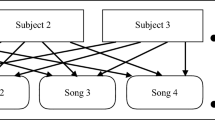Abstract
If we define “good taste” as that prescribed by professional experts in a particular cultural field and ask whether ordinary consumers (non-experts or members of the mass audience) have “good taste,” the evidence from previous studies suggests that the relationship between expert judgments and popular appeal to ordinary consumers is significantly but only weakly positive and is therefore consistent with a phenomenon of “little taste.” Possible explanations stem from the consideration of a variable that might mediate and thereby weaken the relationship between expert judgments and popular appeal—namely, ordinary evaluations, in which non-expert consumers assess the excellence (rather than the enjoyability) of a cultural offering. An earlier experimental study of musical performances showed that ordinary evaluations did intervene between expert judgments and popular appeal to college students so that, in this sense, ordinary consumers did display aspects of “good taste”. New data on over 200 motion pictures corroborate this finding in another cultural context, with actual audience members, and through the use of real-world as opposed to experimental observations.
Similar content being viewed by others
References
Baron, Reuben M., and David A. Kenny. (1986). “The Moderator-Mediator Variable Distinction in Social Psychological Research: Conceptual, Strategic, and Statistical Considerations,” Journal of Personality and Social Psychology 51(December), 1173–1182.
Basuroy, Suman, Subimal Chatterjee, and S. Abraham Ravid. (2003). “How Critical Are Critical Reviews? The Box Office Effects of Film Critics, Star Power, and Budgets,” Journal of Marketing 67(October), 103–117.
Bayley, Stephen. (1991). Taste: The Secret Meaning of Things. New York: Pantheon.
Bourdieu, Pierre. (1983). “The Field of Cultural Production, Or: The Economic World Reversed,” Poetics 12, 311–356.
Bourdieu, Pierre. (1984). Distinction: A Social Critique of the Judgement of Taste. Cambridge: Harvard U. Press.
Bourdieu, Pierre. (1986). “The Production of Belief: Contribution to an Economy of Symbolic Goods.” In Richard Collins et al. (eds.), Media, Culture and Society: A Critical Reader, London: Sage Publications, pp. 131–163.
Bourdieu, Pierre. (1993). The Field of Cultural Production: Essays on Art and Literature, (ed.) Randal Johnson. New York: Columbia U. Press.
Brantlinger, Patrick. (1983). Bread & Circuses: Theories of Mass Culture As Social Decay. Ithaca: Cornell U. Press.
Charters, Stephen, and Simone Pettigrew. (2005). “‘I Like It, But How Do I know if It's Any Good?’: Quality and Preference in Wine Consumption,” Journal of Research for Consumers Issue 5, on-line http://@www.jrconsumers.com.
Craddock, Jim. (2002). VideoHound's Golden Movie Retriever. Farmington, MI: Gale.
Ebert, Roger. (2002). Roger Ebert's Movie Yearbook 2003. Kansas City, MO: Andrews McMeel Publishing.
Eliashberg, Jehoshua, and Steven M. Shugan. (1997). “Film Critics: Influencers or Predictors?rdquo; Journal of Marketing 61(April), 68–78.
Hirschman, Elizabeth C., and Andrew Pieros, Jr. (1985). “Relationships Among Indicators of Success in Broadway Plays and Motion Pictures,” Journal of Cultural Economics 9(June), 35–63.
Holbrook, Morris B. (1999). “Popular Appeal versus Expert Judgments of Motion Pictures,” Journal of Consumer Research 26(September), 144–155.
Holbrook, Morris B. (2003). “Perish Or Publish: On the Cultivation of Bad Taste and Surviving Your Fifteen Minutes of Fame,” Working Paper, Graduate School of Business, Columbia U.
Holbrook, Morris B., and Rajeev Batra. (1987). “Assessing the Role of Emotions as Mediators of Consumer Responses to Advertising,” Journal of Consumer Research 14(December), 404–420.
Holbrook, Morris B., Kathleen T. Lacher, and Michael S. LaTour. (2003). “Popular Appeal Versus the Evaluations of Ordinary Consumers and Critical Experts: An Illustration Based on Musical Recordings of ‘My Funny Valentine,”' Working Paper, Graduate School of Business, Columbia U.
Jackson, Sally. (1992). Message Effects Research. New York: Guilford Press.
Maltin, Leonard. (2002). Leonard Maltin's Movie & Video Guide: 2003 Edition. New York: Plume.
Martin, Mick, and Marsha Porter. (2002). Video & DVD Guide 2003. New York: Ballantine Books.
Olney, Thomas J., Morris B. Holbrook, and Rajeev Batra. (1991). “Consumer Responses to Advertising: The Effects of Ad Content, Emotions, and Attitude toward the Ad on Viewing Time,” Journal of Consumer Research 17(March), 440–453.
Pedhazur, Elazar J. (1982). Multiple Regression in Behavioral Research: Explanation and Prediction, Second Edition. New York: Holt, Rinehart and Winston.
Ravid, S. Abraham. (1999). “Information, Blockbusters, and Stars: A Study of the Film Industry,” Journal of Business 72(4), 463–492.
Ross, Andrew. (1989). No Respect: Intellectuals & Popular Culture. New York: Routledge.
Schindler, Robert M., Morris B. Holbrook, and Eric A. Greenleaf. (1989). “Using Connoisseurs to Predict Mass Tastes,” Marketing Letters 1(1), 47–54.
Strinati, Dominic. (1995). An Introduction to Theories of Popular Culture. London: Routledge.
TV Guide. (2002). TV Guide Film & Video Companion: Compiled By the Editors of TV Guide Online's Cinebooks Database. New York: Friedman/Fairfax.
Twitchell, James B. (1992). Carnival Culture: The Trashing of Taste in America. New York: Columbia U. Press.
Walker, John (ed.). (2002). Halliwell's Film & Video Guide 2003, 18th Edition. New York: HarperResource.
Wallace, W. Timothy, Alan Seigerman, and Morris B. Holbrook. (1993). “The Role of Actors and Actresses in the Success of Films: How Much Is a Movie Star Worth?rdquo; Journal of Cultural Economics 17(June), 1–27.
Zolberg, Vera L. (1990). Constructing a Sociology of the Arts. Cambridge: Cambridge U. Press.
Author information
Authors and Affiliations
Corresponding author
Rights and permissions
About this article
Cite this article
Holbrook, M.B. The Role of Ordinary Evaluations in the Market for Popular Culture: Do Consumers Have “Good Taste”?. Market Lett 16, 75–86 (2005). https://doi.org/10.1007/s11002-005-2774-6
Issue Date:
DOI: https://doi.org/10.1007/s11002-005-2774-6




